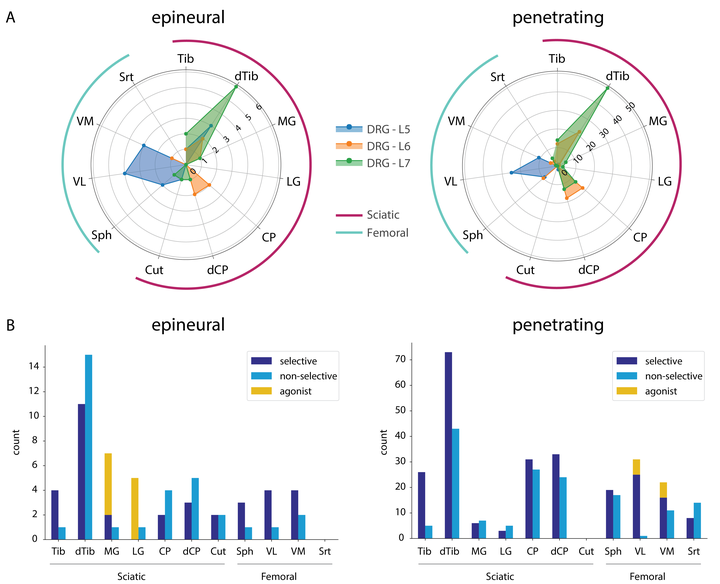Selectivity of afferent microstimulation at the DRG using epineural and penetrating electrode arrays
 Counts of selectively recruited nerves for stimulation via epineural and penetrating electrodes at each DRG
Counts of selectively recruited nerves for stimulation via epineural and penetrating electrodes at each DRG
Abstract
We have shown previously that microstimulation of the lumbar dorsal root ganglia (L5-L7 DRG) using penetrating microelectrodes selectively recruits distal branches of the sciatic and femoral nerves in an acute preparation. However, a variety of challenges limit the clinical translatability of DRG microstimulation via penetrating electrodes. For clinical translation of a DRG somatosensory neural interface, electrodes placed on the epineural surface of the DRG may be a viable path forward. The goal of this study was to evaluate the recruitment properties of epineural electrodes and compare their performance with that of penetrating electrodes. Here, we compare the number of selectively recruited distal nerve branches and the threshold stimulus intensities between penetrating and epineural electrode arrays. Antidromically propagating action potentials were recorded from multiple distal branches of the femoral and sciatic nerves in response to epineural stimulation on 11 ganglia in four cats to quantify the selectivity of DRG stimulation. Compound action potentials (CAPs) were recorded using nerve cuff electrodes implanted around up to nine distal branches of the femoral and sciatic nerve trunks. We also tested stimulation selectivity with penetrating microelectrode arrays implanted into 10 ganglia in four cats. Stimulation evoked activity in just a single peripheral nerve through 67% of epineural electrodes (35/52) and through 79% of the penetrating microelectrodes (240/308). The recruitment threshold (median = 9.67 nC/phase) and dynamic range of epineural stimulation (median = 1.01 nC/phase) were significantly higher than penetrating stimulation (0.90 nC/phase and 0.36 nC/phase, respectively). However, the pattern of peripheral nerves recruited for each DRG were similar for stimulation through epineural and penetrating electrodes. Despite higher recruitment thresholds, epineural stimulation provides comparable selectivity and superior dynamic range to penetrating electrodes. These results suggest that it may be possible to achieve a highly selective neural interface with the DRG without penetrating the epineurium.